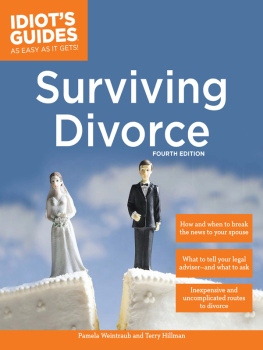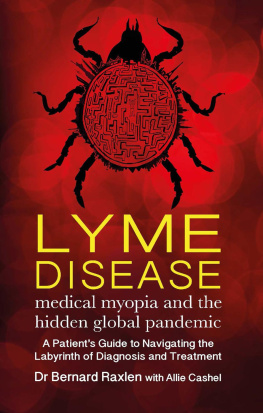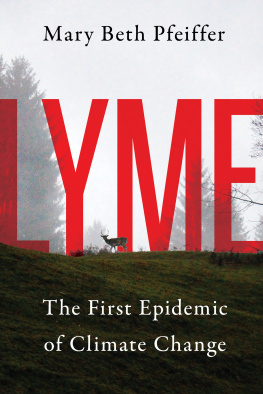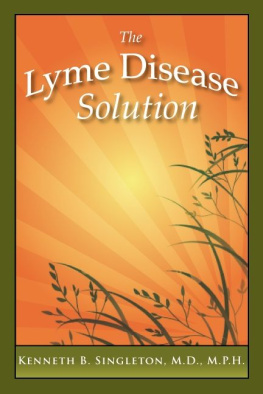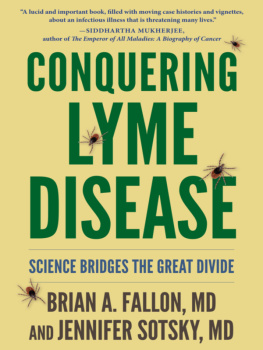
The author and publisher have provided this e-book to you for your personal use only. You may not make this e-book publicly available in any way. Copyright infringement is against the law. If you believe the copy of this e-book you are reading infringes on the authors copyright, please notify the publisher at: us.macmillanusa.com/piracy.
Contents
A Report from the Lymelands, 2013
Walking the streets of Brooklyn, past the bookstores and art house theaters and funky boutiques, I know Ive been saved. Two decades have passed since I entered those Westchester woodsa monumental error that derailed my life and nearly destroyed it for good. Right in the middle of our lives, as our children were passing through adolescence and my husband I sought to climb in our careers, we were crushed by contested disease. Because no one would diagnose our classic cases of early Lyme at ground zero for the disease, we spent years descending ever deeper into illness and many more fighting our way back to health. Eventually we lost our house. We maxed out our credit cards, all in search of the doctors, the medicines, and the therapies that could undo the damage, granting us passage from the shadowland of illness to the coveted world of the well.
Our struggle, chronicled in Cure Unknown , began in 1993. But as recently as 2010, we were still fighting the fallout of late-treated Lyme. Following a new Lyme infection and yet another relapse, our youngest son, by then a college sophomore, reported a sharp and paralyzing pain pulsating through his ears. Now instead of endless sleep, he took to bed in agony. The pain was constant and way too much for him, so unbearable, he said, it might not be worth going on.
Hang in there, I said, and again the hunt was on. It took us almost a year to find two brilliant doctors at two great teaching hospitals who, together, diagnosed the problem: myoclonus of the middle ear, a rare neurological condition in which tiny membranes vibrate rhythmically, in his case against the eardrums, causing excruciating pain. Both doctors said the precipitating cause was Lyme. It took another year and two delicate surgeries before the tensor timpani membrane of each ear was severed and the pain finally gone. After that, another round of antibiotic treatment from his Lyme doctor, Richard Horowitz, truly brought a cure. The last of us to return to health, our son remains well to this day.
Twenty years on, Ive left the Lymelands for higher ground and my personal nightmare is done, but I hear from patients every day. Untreated, contested, and desperately ill, they send me a steady stream of e-mails, post to my Facebook page, track down my mobile number and call me on the phone. Way too many are still functionally disabled, dismissed as psychiatric, left in the trash heap of wastebasket disease, tragically medically abused. Adults still lose careers. Childhoods are still hobbled, and parents still spend fortunes on wrong diagnoses and misguided treatments and cures. In the wake of global warming, Lyme and other tick-borne diseases are spreading outward. The newer the terrain, the deeper the ignorance on the ground. Reports of Lyme in the South are still dismissed as an allergy to tick saliva; large numbers of northeast Lyme doctors are under renewed assault; and the war of the medical worlds, more vicious than ever, rages on.
A Tale of Two Meetings
Yet amid the furor of the fight, science has moved on, and some things have changed. The waters are still muddyyet clearer than before, if only you can tune down the noise.
The first event worth noting is the outcome of the IDSA (Infectious Diseases Society of America) hearings on July 30, 2009. In line with the settlement made with U.S. senator Richard Blumenthal, then the Connecticut attorney general, the IDSA agreed to convene a panel to reevaluate its restrictive treatment guidelines, published in 2006. Physicians following those guidelines would diagnose the disease only in patients with an EM rash or gross inflammation, from heart blockage to meningitis to swollen knees, along with passage of the embattled two-tier test. In what felt like dj vu to me, the same old enemies had taken to the podium to rehash the same old fight: Lyme or not Lyme? Persistent or not persistent? Treat for weeks---or for months? Listening to the IDSA hearing stream over the Worldwide Web, I heard the arguments thrum in my head like tribal chants. An old Lyme soul myself by then, I knew the outcome was preordained. The new panel like the old one validated the 2006 guidelines, essentially setting the IDSA viewpoints in stone and making them even more entrenched.
Perhaps the newest note came from Allison DeLong, a Brown University biostatistician who challenged the IDSAs interpretation of the linchpin studiesthe treatment trials on which the guidelines were based. (DeLongs study was published in Contemporary Clinical Trials , a peer-reviewed journal, in 2012.) Her most important conclusions: the two Mark Klempner trialswhich more than others, were cited as evidence that the guidelines should standwere statistically weak.
The gist of the problem was this: Using a standard quality of life survey, a question-and-answer self-test called the SF-36, Klempner and colleagues at the New England Medical Center in Boston had set the bar for average improvement between scores of 7 and 9 for the first trial and between 9 and 13 for the next; either way, the bar was far higher than that used to evaluate treatment success in other chronic diseaseswhere clinically meaningful treatment effects were generally recorded between 2 and 5.
But Klempner had been stuck: Using the lower bar would have required more patients, 400 at least, for each of his two study arms; yet only 78 and 58 patients, respectively, had actually been enrolled in each trial. The low enrollment, a function of highly restrictive entry criteria and patient suspicion of the study itself, had diminished Klempners ability to detect clinically meaningful improvements from treatment. If guidelines authors had overvalued Klempner, DeLong and her team reported, they had undervalued two trials from Stony Brook and Columbia: more statistically sound than the Klempner trials, these studies had found significant treatment improvement for symptoms of fatigue and pain.
In short, the guidelines panel had based its conclusions on studies that lacked statistical power. The inability of these trials to demonstrate a statistically significant finding provides neither proof of the absence of a clinically meaningful treatment effect nor evidence that patients with persistent symptoms suffer from a post-infectious syndrome, DeLong and her coauthors said. Results, it seems, can be in the eye of the beholder. In choosing which study to favor, the guidelines committee had followed statistically weak results.
In October 2010, the prestigious Institute of Medicine (IOM) stepped into the fray, hoping to find some clarity and pave a middle ground where the guidelines hearings had failed. Its comprehensive two-day workshop and the April 2011 report that emerged ( Critical Needs and Gaps in Understanding Prevention, Amelioration, and Resolution of Lyme and Other Tick-Borne Diseases ) took a thoughtful stance. Lines in the sand have been drawn, sides have been taken, and frustration prevails, the IOM panel wrote in the preface to its report, adding that a process of conflict resolution seems necessary for creating a new environment of trust.
Though many patients boycotted the NIH-funded event, protesting the balance of speakers, the institute eventually adjusted the lineup. The presenting scientists, many of them already profiled in Cure Unknown , helped create the most nuanced government document on the Lyme dilemma to date. The meeting examined the gaps in testing; the spread of the disease; the emergence of coinfections; the complex ecologies on the ground; the impact on families and children. Importantly, the IOM had put Lymes big questions back into play: Who even had Lyme disease? Which tests were viable? What other infections were part of the mix? And what was the truth, when you came right down to it, about the spirochetes ability to elude immune attack after treatment and persist?
Next page

